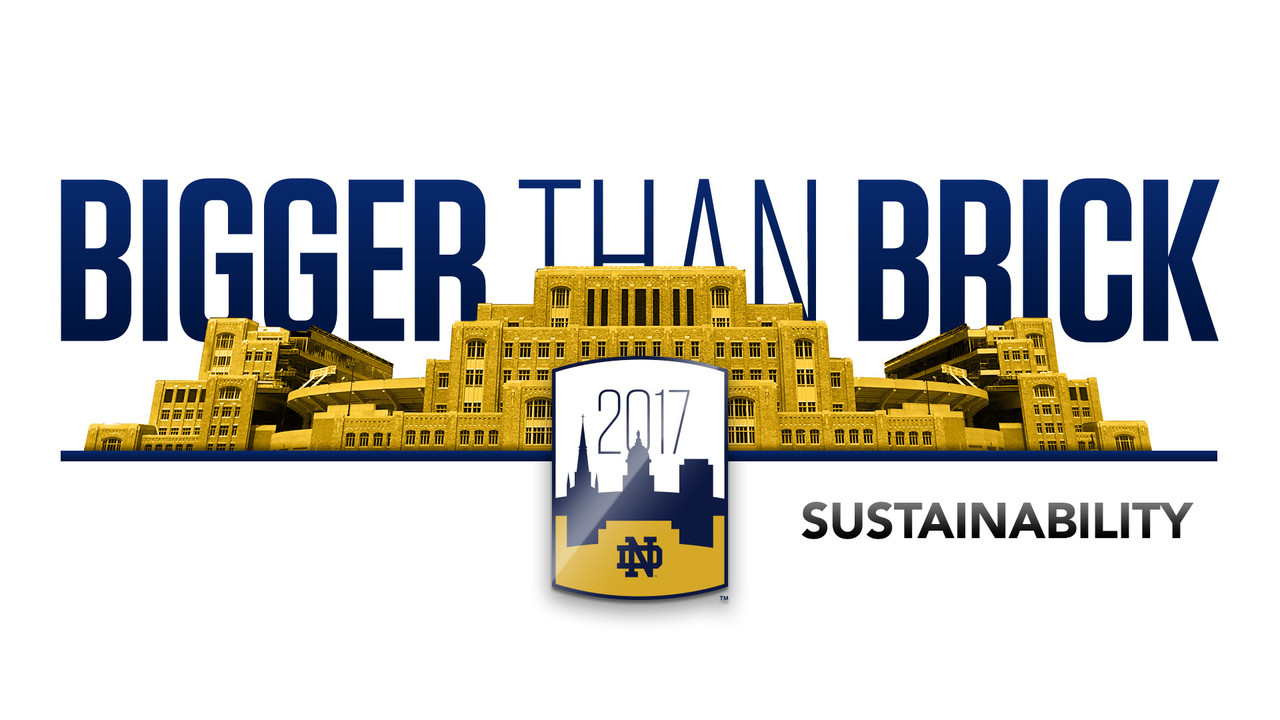July 20, 2017
Throughout the 2017 football season we will be giving you a behind the scenes look at the Campus Crossroads Project on social media – you can follow along with the #NDBiggerThanBrick hashtag. Why #NDBiggerThanBrick? Back in Notre Dame’s 1930 Alumnus magazine, it was stated “Notre Dame is bigger than brick and far more than mortar.”
The bricks of Notre Dame Stadium may be light brown in color, but the theme is “green” when it comes to sustainability for Irish football games and for the new structures surrounding the stadium. Here’s what’s happening in 2017:
At Notre Dame Stadium:
- One hundred percent of the replaced stadium seating from the lower bowl has been repurposed or recycled. None of the replaced seating was disposed of in landfills
- New LED lighting has reduced power consumption by 60 percent.
- For the first time fans will be able to recycle bottles, cans and paper products they purchase inside the stadium via single-stream recycling opportunities.
- A game day food donation program has been developed, substantially decreasing waste from the stadium while also providing consumable food to local nonprofit agencies.
On Notre Dame football game days:
- Student groups and parking attendants provide recycling bags to tailgaters. Cardboard boxes are picked up from student concession stands on campus.
- Instructional attendants walk through tailgating areas to interact with guests on waste disposal.
- Recycling push-carts move through tailgate areas to help pick up trash and recycling by hand.
- There will be a sustainability video and messaging on the ribbon boards at each home game beginning this season.
At Corbett Family Hall, Duncan Student Center and O’Neill Hall:
- All three buildings have been designed to seek LEED certification (Leadership in Energy and Environmental Design, a worldwide green building certification program) silver level.
- Total energy efficiency of the three buildings is 18 percent greater than that required by code. They are served by the University’s on-site central power plant, which, as a co-generation plant, is more efficient than public utility. The power plant’s heating and cooling process is aided by a new renewable geothermal pump system which allows the plant to take advantage of the constant underground temperatures.
- Most of the building roofs are covered by a living roof. High-efficiency thermal envelope-insulation is incorporated into walls and roofs. High-efficiency central fan systems utilize a gridded array of smaller fans controlled by variable speed fans. Direct digital control systems in many rooms and spaces rely on individual settings based on occupancy sensors and setback controls. High-performance window glass glazing reduces space overheating.
- Green roofs cover the majority of roof areas, mitigating storm water run-off and increasing energy efficiency. Water efficient plumbing fixtures expect to reduce water use 35 percent. Storm water bio-retention areas used during construction helped control erosion and sedimentation into storm water run-off.
- LED lighting provides 30-50 percent energy reduction compared to conventional sources.
- Approximately 75 percent of construction waste was diverted from landfills. More than 20 percent of building materials consisted of post-consumer and pre-consumer recycled content–and more than 20 percent was manufactured or harvested regionally.
- All adhesives and sealants in building interiors comply with South Coast Air Quality Management District VOC limits. All paints and coatings comply with the Green Seal Standard. All carpets meet Green Label Plus standards.
- Green cleaning products are used–and an integrated pest management plan reduces the need for chemical pest treatment.
- Ninety bicycle racks are in place, and there are designated low emitting vehicle (LEV) priority parking spaces available.
It’s all about blue and gold turning green.







